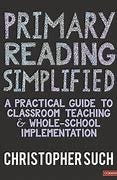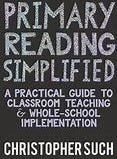A great new book on teaching reading
...but for me The Art and Science of Teaching Primary Reading is still the GOAT!
Earlier this year, Christopher Such published his second book on Primary Reading. As I have mentioned before, his previous book was my top recommendation for ECTs starting out in primary. So, would Primary Reading Simplified topple The Art & Science of Teaching Primary Reading (“Art & Science”) from its throne? And if you already have Art and Science, is it still worth getting Primary Reading Simplified?
As Christopher Such explains in his Introduction, the reason for creating Primary Reading Simplified was to offer more than the evidence-informed principles of reading found in Art & Science and to set out his preferred path to create a reading programme in primary schools. Accordingly, it goes into much more detail about certain reading lesson structures that were only sketched out briefly in Art & Science. These reading lesson structures are the heart of Primary Reading Simplified and covered in Part III. In my experience, these kind of structures are still unusual in placing whole-class engagement with text at the forefront of reading rather than the futile attempt to build transferable reading skills which is still followed by many primary schools. Chapter 2 of Primary Reading Simplified demolishes this and explains why it is so damaging:
Many teachers who might otherwise spend precious classroom developing pupils’ understanding and appreciation of written language - something that genuinely would support improved outcomes - instead target illusory skills. They inadvertently replace meaningful instruction with years of unnecessary test preparation…. (p.21 of Primary Reading Simplified)
Chapter 2 develops this point which was made briefly on p.56 (and elsewhere) in Art & Science. If you weren’t convinced there that the VIPERs-style approach to reading was a waste of time, you surely will be by reading Primary Reading Simplified.
Moving on to the various reading structures,1 these are covered in bite-sized chapters which will be familiar to readers of Art and Science. There are 3 core structures - Fluency Reading, Extended Reading and Close Reading but also an introductory structure - Scaffolded Reading. In addition, Extended Reading comes in two versions - simple read-aloud by the teacher (before 80% of children are fluent) and a version involving mixed read-aloud by the teacher and independent reading by children.#
The three core structures each target one reading aim as follows:
Fluency Reading - building fluency through practice.
Extended Reading - read plenty of thoughtfully chosen texts.
Close Reading - discuss texts in depth.
Scaffolded Reading
This lesson structure is a useful bridge between phonics and whole-class reading. In very short summary, it involves some teacher reading, some echo reading of a text, some paired reading and a brief discussion. You could use with a decodable text but also some simple non-decodable books (I can see it being both fun and useful with quality picture books). Personally, I think it would also be a great end to a phonics lesson as a 5-10 minute bringing together of a class after independent practice.
Fluency Reading
This structure is basically repeated oral reading in pairs and is a development of a structure introduced in pp. 41-47 of Art & Science. That makes it sound simple and in some ways it is but it requires strong routines and (in my experience) a level of understanding from the children of why it is useful.2 Based on limited experience, my teacher training (on a very well-regarded PGCE) and the data I discuss here, I think this is widely neglected in primary schools. It might be one of the most important things we can do for struggling readers and this chapter explains it fully and deals with likely problems in implementing it. Although I had created something very similar based on Art & Science, there are some valuable tweaks here.
Extended Reading - less developed reader version
In a class where less than 80% are fluent readers, this structure is suggested. It involves the teacher reading the text aloud with children following in their own copy. The teacher pauses occasionally to discuss the text but these are focusing on comprehension rather than analysis. Similarly, the teacher might model how to tackle a particularly challenging part. There are some modifications suggested if it isn’t possible to give children their own copy. It is noted that this is passive rather than active decoding and research on its effectiveness is rather meagre.
Extended Reading - more developed reader version
In a class with 80% or more fluent readers, the same structure is suggested but with teacher reading interspersed with children reading short pieces of the text independently, making a one-sentence summary and re-reading to check they understood correctly.
Although it is not stated, these two structures seem to me to be aimed at what I think of as the “class reader conundrum”. The conundrum is that we can be reasonably sure that there are large benefits to reading whole texts with a class (usually a novel but also non-fiction or poetry). It creates a valuable piece of shared cultural capital and the Faster Read project suggests that it also pays huge benefits in terms of reading comprehension. However, it’s not exactly clear what is the best way of actually reading the text with a class in terms of developing their reading. This is certainly one sensible way of tackling it but I can see some issues. For example, if this FFT data is consistent across UK primary schools, you might never get to 80% fluency even in a Year 6 class. Of course, if you are consistently using the fluency reading structure, you would hope and expect to have much better fluency than the average but it points up the need to think carefully about the context. I think this area is the trickiest part of teaching reading and hope to return to it in a future blog.
Close Reading
The final structure is a deeper investigation of a text or extract. The basic structure is that the text or extract is read and then discussed in detail using a variety of techniques outlined. It’s an excellent guide to tackling this kind of a lesson which can often feel daunting to a non-English specialist.
Although the heart of the book is these structures, there is lots of other useful material in there. In particular Parts IV, V and VI on implementing change, building a reading curriculum & culture and looking at reading development across the curriculum will be invaluable to any reading leads or members of SLT who have wider responsibilities for developing reading. This isn’t something you get in anything like this level of detail in Art & Science.
Conclusion
As you can see, I am a great admirer of this book. I think it sets out a coherent plan for improving reading across the school. I anticipate that lots of my readers will already have a copy of Art & Science. However, for those who don’t - should they buy that or Primary Reading Simplified? I think the correct answer to this is “both” because although there is some overlap, they are two different books with different emphases. Art & Science is more about the “why” of teaching reading and Primary Reading Simplified more about the “how”.
If you can only buy one, I confess a bias in favour of Art & Science because it was so influential for me in my early career but there are a couple of reasons why I still think it is the best of all time even though Christopher Such disagrees with me.
a) It is so incredibly informative about the science of reading in a very short book. It’s just 153 pages long plus a glossary and some very useful appendices. ( I later read Seidenberg’s Reading at the Speed of Sight and learnt very little from that which I hadn’t already learned from Art & Science).3
b) Ultimately, I think it’s important to have a good grounding in “why” we should teach in a particular way before looking at the “how” if we are to avoid lethal mutations. There’s probably enough on the “why” in Primary Reading Simplified for most people but if you really want to get into the details, Art & Science explains it all with superb references that you can follow up.
Trying to take my bias out of it, two other factors in choosing which one of these books to buy are (a) your personal disposition and (b) where you are in your career. If you want to know all about the research and some short indicators of what to do in the classroom whilst you find your own way, buy Art & Science. If you would rather have a guide to how run reading lessons, buy Primary Reading Simplified. Similarly, if you are a classroom teacher early in your career, my recommendation would still be for Art & Science - it will help you understand what you are doing and make tweaks to improve it even if you are in structures designed by others that you have little influence over. On the other hand, if you are a reading lead, buy Primary Reading Simplified because of its practical advice and useful guide to whole school implementation. Either way, you won’t regret the investment.
There is a short and convincing explanation of why the reading structures are useful on p.70. I was particularly convinced by reason 4 - that the structure allows skills in teaching reading to be developed incrementally. It is important that structures can be used by novice and expert teachers alike.
I find that some children, often strong readers, don’t like the re-reading. The metaphor of “rehearsal” is often a good way of explaining why fluency is important.
If you are old enough to remember when we bought music albums, you will recall that you would buy them because of a couple of great singles only to find there was a lot of OK filler material as well. Art & Science is like that rare album where there isn’t any filler. At the risk of stretching the metaphor beyond breaking point, I am not suggesting that there is filler in Primary Reading Simplified but some of the chapters relating to implementing change won’t be that relevant to classroom teachers.





Great analysis of both books here! Thank you 😊